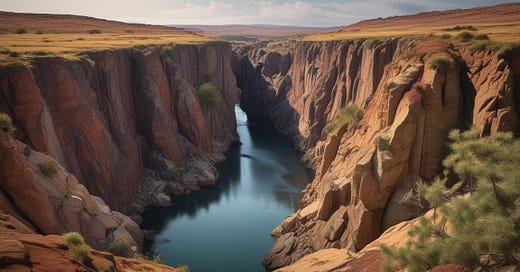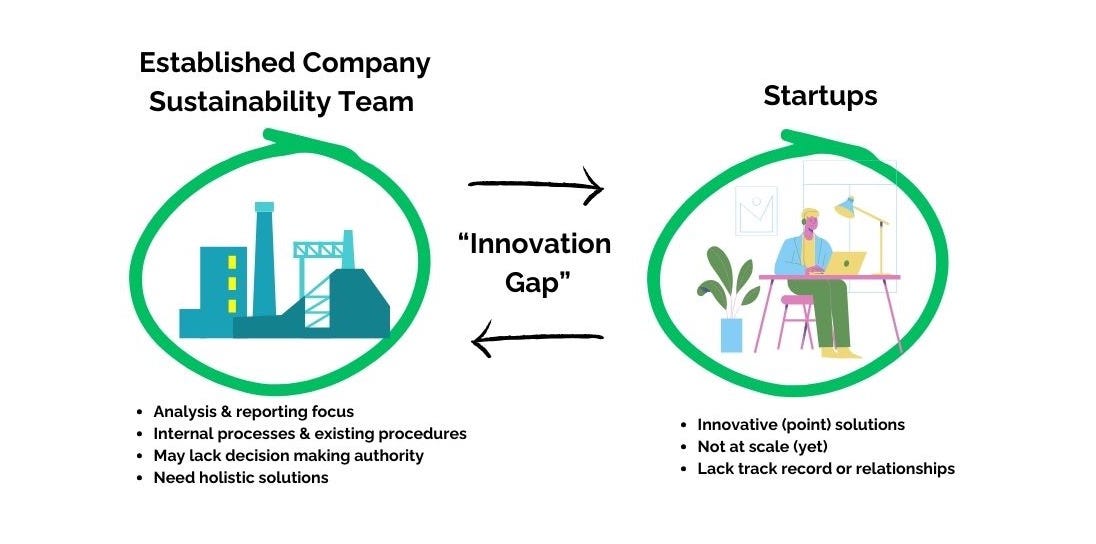Mind the (Innovation) Gap
How Sustainability Innovation Bridges Cutting-Edge Technology and Established Company Needs
There’s a yawning gap in the sustainability & climate technology space that could derail our efforts to combat the climate crisis—not to mention, jeopardize your company’s growth & profitability. This became obvious to me when I met a company that was successfully bridging it.
I spoke to a sustainability leader at a local building-products manufacturer last week whose entire focus is on bringing new technologies into her company’s products, processes and supply chains. As a result of her work, not only are many of their products carbon-neutral, they’re actually carbon-positive: They remove more carbon over their lifecycle than they create.
Through hard work, her team had attained the climate Holy Grail: Products that, the more they sold, the more positive climate impact they made. As you’d imagine, their sales are exploding—oh, and the climate-friendly solution is more profitable too.
The more I learned about how her team operated, though, the more I realized they’re the 1% getting it right. Her team identified sources of carbon in their products & supply chains, then ruthlessly innovated—internally, with existing suppliers and with startups—to pull carbon out of their system.
It’s the fact that they innovated with the aid of their suppliers and smaller startups in the space that made her work so unique—and so effective. They successfully put a lot of small pieces together to solve a bigger puzzle.
Most sustainability teams lack the resources to do this effectively.
That’s the gap that we must fill more broadly.
Islands in the Stream
Within climate technology (and sustainability generally) there are two islands, separated by a giant chasm:
On the one side sit corporate and established company sustainability teams. They’re focused on carbon accounting, reporting and the day-to-day internal administrative work needed to advance their sustainability mission (read: “internal politics”). When they implement changes in their organizations, it’s typically through other groups—operations, supply chain or R&D.
On the other side of the chasm sit a new generation of climate tech startups—thousands of new companies with new technologies who, combined, raised $50B in capital last year alone.
These startups want to work with and sell to the established companies, and they often have innovations that established players need to reduce costs, improve their carbon profile and grow their business.
But there’s a catch:
Even if a startup knows how to sell to an established company (often they don’t), they’re selling a single, point solution.
And the established company typically needs not a point solution, but an ecosystem of solutions for their business.
Consider something as transformative as green steel for the commercial building industry. Carbon-free steel is a giant breakthrough for a product that traditionally is very carbon intensive—7% of global carbon emissions, by some estimates.
But, if you’re a construction company, steel is just one of the inputs you need for your construction project. You still need concrete, lumber, glass, mechanical systems, and all the other thousands of components that go into a modern building.
If steel is only a piece of the overall puzzle, is the typical builder going to deal with the complexity of researching, identifying, sourcing and incorporating a new product—not to mention the risk of product failure—just for a small overall impact?
Probably not.
Hence the gap.
Innovation Fills the Gap
This is where climate and sustainability innovation comes in.
The typical sustainability team doesn’t have the resources to systematically investigate new startups and cutting-edge solutions that could meet only a fraction of their needs. And they certainly don’t have the time and resources to create an ecosystem of solutions, with potentially unproven vendors, to meet their holistic climate need.
This is exactly what a good innovation team does.
An innovation team can take an existing process or challenge, break it into the specific components and technologies, then identify the best solutions available to meet those problems.
For our builder, their challenge isn’t finding a green steel vendor—it’s creating a low/no-carbon building. That may require a reworking of their entire supply chain & subcontractor network.
In that scenario, the innovation team would evaluate the carbon generated by each step of the building process and each component. Then, identifying the most carbon-intensive elements, the team would work through the new technologies that exist that could revolutionize how that component—and in total, how the entire building—is created.
There’s another nuance at play here too: A good innovation team also knows how to vet, talk to and work with startup players—no minor skill. Dealing with an 18-month-old company that’s just completed a successful prototype of their new technology is vastly different than working with IBM. But, if we’re going to address the climate crisis fast enough to have a meaningful impact the business community needs to adopt climate-positive technologies ASAP.
(And if you want to create a sustainable competitive advantage from adapting to a changing climate, you have to navigate this ecosystem).
Also, note what we’re not taking about…
We’re not talking about taking on the cost and risk of building a new technology from scratch. Can a good innovation team do this? Yes. Is it typically needed? Probably not. As many others have pointed out, we don’t need new technologies to fight climate change.
What we do need is the clever integration of existing solutions into new or revamped products, quickly and at scale.
And that’s the role of climate innovation.




